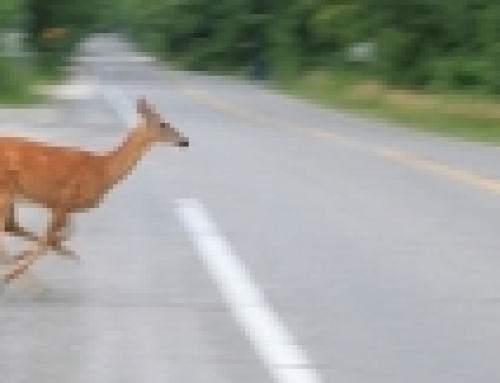SEASONED RIDERS
By Dennis P. (Wombat) Dougherty
I was sitting at the back of the room during one of our recent club meetings and I noticed how much our club membership has ‘matured’ over the years since I joined. More and more of us probably have more riding days behind us than we do in front of
us. Like it or not, we’re all getting older. Those of us 45 or older have crossed over into the category of
‘Seasoned Rider’. We’re talking age, not skills. Many younger than 45 have lots of miles and are road tested veterans with lots of
riding experience. On the other hand, there are others in the club that are older than 45 with little riding experience. This discussion is simply about ‘seasoning’ due to age and the impact it has on our skills and judgment whether you’ve been riding for 40 years or 40 days.
What I’m about to write about won’t be the most fun thing to think about. But getting old is a fact of life. Understanding the impacts of aging on our riding skills is key to a long life of safe riding. I read once that a lot of people get old and quit riding. I believe the opposite is true; you get old when you quit riding. Hopefully some of what is covered here will help us all ride happily and safely far into the halcyon years of our life.
There are five primary areas that are impacted most as one gets older:
Strength and Stamina
Have you noticed that your bike seems a bit heavier this year or takes a little extra effort to maneuver it around when not under power? Well, once you hit the ripe old age of 30, you lose about 10% of your strength per decade. So, by the time you reach 60, unless you were on a rigorous strength building routine, you would have lost about 30% of the strength you had at 30. Also you get older, your natural endurance decreases as your body processes oxygen (O2) less efficiently than it does when you’re younger. You may find you tire more easily or run out of breathe sooner.
Vision
Night vision in particular rapidly deteriorates as you get older. It becomes more difficult to resolve objects and movement at night and usually there is more glare and ‘flaring’ from oncoming lights. As you age, you need 4 times as much light at night to see as clearly as you did in your younger days.
Peripheral and depth perception often decrease as well, potentially causing you to misjudge depth and distances, both in front and behind you. It will take more effort to get a complete and
accurate ‘picture’ of the riding environment surrounding you.
Hearing
Loss of hearing is a natural part of aging. Once you hit your 50’s you naturally lose about 20% of your hearing. This increases to 30% as you hit 60. If you’ve been riding for a while hearing loss can be accelerated, especially if you didn’t wear earplugs over the years.
Reaction Times
We all like to think that we are as quick on the draw mentally and have the reflexes we did when we were younger. But the fact is, our reaction times significantly decrease as we get older. This is due to both natural physical and mental deterioration. At 50 we don’t move as fast or think as fast (process information) as we did in our twenties. Our mental acuity continues to decline naturally as we age. It is not unusual for reaction times to double by the age of 40 from what they were in your 20s. Over 55 they can quadruple (4X).
Control Sensation and Rider Comfort
Remember the days when you could ‘feel’ the slightest variation in your ride just by touching your controls or listening to your engine and road noise? How about riding hard from dawn to dusk with only short stops for fuel and sustenance? Well, all your senses start to dull through aging and your stamina decreases. Continuing to rely on those sensations and pushing yourself past your stamina comfort level can be a very dangerous thing. Couple that with reduced reaction times, it can be a recipe for disaster. If you are on a multi-day ride, it can have a compounding effect. It will move you into a much higher risk riding profile, and most likely take a lot of the pleasure away from the ride itself due to increasing fatigue and lack of comfort.
So is it time to take the last photo of your ride and put your trusty iron steed up for sale in Cycle Trader? Absolutely not! As I said earlier, you get old when you quit riding! With a little bit of planning and common sense most people should be able to ride well into their retirement years.
Here are a few hints and recommendations to help you SAFELY transition into the Seasoned Rider phase of your life. If you’re already there, they may make you a safer rider and keep you riding longer:
• First of all, be honest with yourself. Accept the fact that you’re older and start to watch for some of the signs of aging mentioned above and their impacts on how YOU ride.
Come up with a plan to minimize or counter act aging impacts and stick to it! Realize that you will need to update your plan and perhaps do other things as you continue to age.
Prepare for riding season. During the months leading up to riding season, spend some time getting in shape to ride. This includes both strength and aerobic training as well as mental preparedness. If you ski or golf or participate in any other physically demanding sport, I imagine you do exercises in preparation for those sports to help avoid injury.
Well, riding is a very demanding sport both physically and mentally. Get both your body and mind in shape. Compared to most sports, the downside of not being in good shape
both physically and mentally for riding can be much more disastrous.
• Get your eyes tested at least annually. The closer to riding season the better. Consider tinted lenses or other options to improve both your day and night vision. It may make sense to have prescriptions and tints that you only wear when riding. As you get older, seriously consider minimizing night riding for all the reasons mentioned before. Riding at night requires a higher level of reaction skill and perception acuity than riding during the day. If you do ride at night, give yourself plenty of room, slow down, and don’t override your headlights.
• Rightsize your ride. If that big honker cruiser or lightning fast sport bike seems a bit too much to handle as you get older, consider downsizing or moving to a different style ride. If a new ride is not required, customize the one you have to make it safer and easier for you to ride.
• Watch the medications! It used to be hard to find an aspirin in my house let alone any other medication. Now as I’ve gotten older my doctors seem to think I need some help keeping my body functioning properly and its chemistry in line. Be more aware of drug interactions and impacts particularly related to perception, acuity and reaction times. If any drug or combination says “Don’t use when operating heavy machinery”, think at least twice about riding on the days/times you are taking them. In my book a motorcycle is ‘heavy machinery’. Check with your doctor. Tell themyou ride and ask if what you are taking could have an impact. If they do, ask his advice on alternatives that cause you less risk.
• Increase space and distance. Give yourself A LOT more time to Search, Evaluate, and Execute when riding down the road. Space and distance can do a lot to offset increased reaction times, declining eyesight and help to maintain spatial awareness. As Top Cats one of the things we teach in G.R.A.S.S. class is how we ride in formation, using the 2 second behind, 1 second adjacent guideline. It is a beautiful sight going down the road. Not only is it something to behold but it also creates somewhat of a safe cocoon for the riders in the formation as everyone shares the same riding behavior expectations. Having said that, riding in formation takes skill and practice. If you are riding with us and find some of those skills may have diminished and/or you’re not as comfortable riding by those guidelines, talk to your road captain in advance of departure and they will work with you to find a place in the formation that will allow you more space and distance to help keep you and the other riders safe.
• PRACTICE, PRACTICE, PRACTICE! It may seem odd to suggest to someone who has been riding for 10 or more years to practice, but that is one of the best approaches to keeping your riding skills sharp and your reaction times low. At the beginning of riding season, take a few water bottles filled with sand or rocks and go out to a spacious vacant parking lot. Practice maximum performance braking (quick stops), swerving, braking in a curve, and limited space maneuvers. These are the most critical maneuvers that rely heavily on reaction time and skill. When riding,constantly practice spatial awareness techniques. I call it the ‘Bobblehead Mambo’. Keep your eyes and head constantly moving from side to side searching and looking to keep you aware of what is coming at you from in front and sides well down the road as well as what may be sneaking up on you from behind. You may be surprised at what you start to see.
Perhaps one of the easiest and most fun ways to practice is to take a riding class. They cost anywhere from free to a few hundred dollars. Put yourself in the hands of a professional riding instructor some weekend early in the season to help polish and maintain those all important skills. There are many courses to choose from. However, one of the best to sharpen your basic skills is a Basic Rider Course. You’ve already got your ‘M’ endorsement on your license (or at least you should have) so you don’t need to worry about the skills evaluations. Just focus on improving your own technique. If you feel you have the basics mastered, take an advanced course. They cover a wide range of skills development and you almost always do them on your own motorcycle.
As an MSF instructor, I’m particularly aware of the impacts of aging as we cover it as part of our curriculum. However, as a ‘Seasoned Rider’ myself, I’m specifically aware of them through my own personal experience. Each year it takes a little more effort to ride skillfully and keep my head in the game. Frankly, one of the reasons I teach, besides the personal satisfaction I get from sharing my passion for riding, is the fact that I have to keep my personal mental and riding skills sharp to demonstrate proper riding technique as flawlessly as possible to my students. I spend many hours each riding season practicing the basic riding skills as well as consciously exercising the mental focus that one needs to be safe. I continue to practice different skills on each and every ride I take.
Legend has it that Ponce de Leon searched Florida and Puerto Rico for the Fountain of Youth. Well, he never found the magic elixir. As such, we’re all doomed to the same fate of aging. Personally I feel one of the best things to keep you young is riding a motorcycle. With a little bit of self awareness and honesty, a disciplined approach to keeping our physical and mental skills sharp, we all should be able to ride safely for a very long time. One of the things that makes our club great is the legacy of our Seasoned Rider membership. I’d like to see that portion of our membership continue to grow through our existing roster and attracting others to the club. And who knows, maybe one day we will plan a Top Cats Adventure Ride to Florida to carry on Ponce’s quest!
Ride Safe!
Wombat





